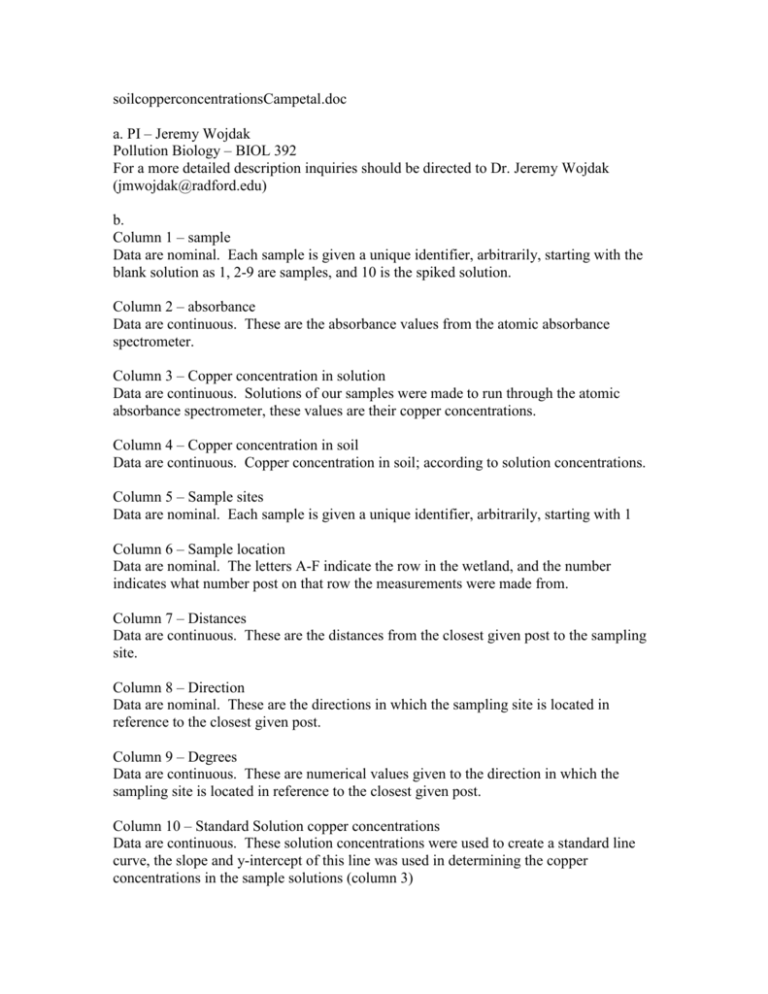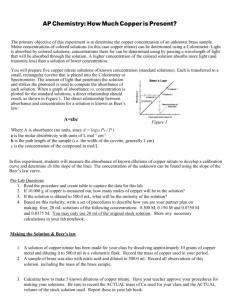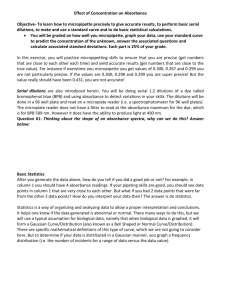Notes - Radford University
advertisement

soilcopperconcentrationsCampetal.doc a. PI – Jeremy Wojdak Pollution Biology – BIOL 392 For a more detailed description inquiries should be directed to Dr. Jeremy Wojdak (jmwojdak@radford.edu) b. Column 1 – sample Data are nominal. Each sample is given a unique identifier, arbitrarily, starting with the blank solution as 1, 2-9 are samples, and 10 is the spiked solution. Column 2 – absorbance Data are continuous. These are the absorbance values from the atomic absorbance spectrometer. Column 3 – Copper concentration in solution Data are continuous. Solutions of our samples were made to run through the atomic absorbance spectrometer, these values are their copper concentrations. Column 4 – Copper concentration in soil Data are continuous. Copper concentration in soil; according to solution concentrations. Column 5 – Sample sites Data are nominal. Each sample is given a unique identifier, arbitrarily, starting with 1 Column 6 – Sample location Data are nominal. The letters A-F indicate the row in the wetland, and the number indicates what number post on that row the measurements were made from. Column 7 – Distances Data are continuous. These are the distances from the closest given post to the sampling site. Column 8 – Direction Data are nominal. These are the directions in which the sampling site is located in reference to the closest given post. Column 9 – Degrees Data are continuous. These are numerical values given to the direction in which the sampling site is located in reference to the closest given post. Column 10 – Standard Solution copper concentrations Data are continuous. These solution concentrations were used to create a standard line curve, the slope and y-intercept of this line was used in determining the copper concentrations in the sample solutions (column 3) Column 11 – Absorbance of Std. copper solution Data are continuous. These are absorbance values from the atomic absorbance spectrometer for the standard solutions. Methods Gathering samples. Soil samples were taken from 8 different points within the “low marsh” area of wetlands, which is where most of the copper would settle out or be absorbed by aquatic plants and invertebrates. Each sample was placed in a plastic sampling bag and labeled according to the number of the site from which the sample was taken. Locating sample sites. Measurements were also taken so that the most precise location of sampling sites could be recorded for other future experiments (Figure 1). There are PVC pipes set up through out the wetland that indicate known locations by a number and letter, A-G and numbers depend on the length of the row. Once the number and letter of the closest known location was recorded, the distance from the known location to the sampling site was measured, in meters, using a taut tape measure. Also, using a compass, the direction in degrees corresponding to the sampling site was recorded. For more detailed instructions, see Dr. Jeremy Wojdak’s locating sampling sites in the wetland procedure handout. Preparing samples for atomic absorbance spectrometer. After the samples were collected, they were set out to dry on newspaper at room temperature for 5 days. Then, with the help of the chemistry department, the samples were prepared as solutions for analysis. Once dry, 0.5g of each sample was weighed out on a digital balance. Each of the 0.5g samples was added to 10mL of HNO3. Then each of the 8 solutions was placed into specialized cylinders for the digestion microwave. Two control cylinders were prepared as well. The blank control contained only 10.0mL of HNO3. The spiked control contained 2 ppm of a standard solution of copper. The 10 cylinders, containing the 8 sample solutions and 2 control solutions, were set in the digestion microwave and run for a trial of about 45 minutes; the temperature was raised to 175 degrees Celsius in 5 minutes 30 seconds, then the temperature was held at 175 degrees Celsius for 10 minutes, and allowed the samples to cool in the microwave for 30 minutes. After the microwave cooled, the cylinders were removed and the gas inside was vented under a chemical hood. The digested samples were then poured through filter paper into ten 50mL volumetric flasks. Deionized water was used to fill up the remainder of the flasks, so that each flask contained 50mL of solution. Each solution from the 50mL volumetric flasks were poured into test tubes, covered with parafilm, and placed in a rack in the order of which the samples were taken; for example, test tube 1 contains soil taken from the input, and test tubes 9 and 10 were the two controls. Using the atomic absorbance spectrometer. In flame atomic absorption spectrometry, a sample is aspirated into a flame and atomized. Different elements burn to emit different wavelengths of light. A light beam is directed though the flame, into a monochromator, and onto a detector that measures the amount of light absorbed by the atomized element in the flame. Also, because each metal has its own characteristic absorption wavelength, a source lamp composed of that element is used. The amount of energy at the characteristic wavelength absorbed in the flame is proportional to the concentration of the element in the sample over a limited concentration range. The atomic absorbance spectrometer used in our experiment is fully automated; any calibration of the machine or software was done so by Dr. Joe Wirgau of Radford University’s chemistry department. The absorbance and concentrations of copper in the solutions were recorded and organized into a table by the machine’s software. Using a standard curve (Figure 2) and the concentrations of copper found in our 8 sample solutions, we calculated the concentration of copper found in each soil sample.







